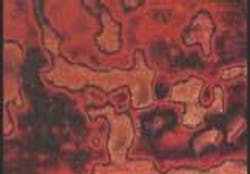Colossal nonlinearity offers new efficient wavefront correction
A team of researchers from the University of Ancona (Ancona, Italy) has found what appears to be the largest nonlinear optical response ever observed in liquid crystals (LCs)—one that is eight orders of magnitude larger than the so-called giant optical nonlinearity. Not only have the researchers demonstrated optically activated gratings with better than 20% diffraction efficiency, but they have shown that the nonlinearity does not come from the bulk properties of the material, but from interaction at the substrate. This means that the efficiency of the nonlinearity does not rely on having thick layers of the material. In addition, the team has demonstrated optical phase conjugation and wavefront correction with the material.
The LC in question is nematic pentyl-cyano-biphenyl doped with methyl red dye—and the role of the dye is crucial. Early experiments by another group showed signs that the dye offered high nonlinearity, although the reason was not clear. Initially it was thought that some kind of photorefractive effect was taking place, with a photoinduced field reorienting the molecules, but theoretical studies showed that the fields produced by incoming light beams were not strong enough to do the job. Another theory was that photoisomerization of the dye molecule was taking place: a photon would hit the molecule, twist the molecular shape (without changing composition), and thus help to reorient the neighboring LC molecules. This too was rejected as a total solution because the effect was three times larger than would be expected through this mechanism.
What Liana Lucchetti and her team have shown is that surface-induced nonlinear effects are responsible for the highly nonlinear phenomena observed.1 Essentially, she says, the orientation of the crystals is dependent on how they are anchored to the surface: once those near the surface have been optically excited and reoriented, the rest of the bulk will turn too. This is what makes the whole process so efficient.
Aligning the molecules
To make the best use of this effect, however, the LC should be as free to move or turn on the surface as possible. Aligning the LC molecules reliably at the same time—crucial for conventional light-modulation applications—turns out to be difficult. Among the experiments the team performed was examining the performance of an LC cell in which one side had been treated with a surfactant routinely used to improve alignment and the other side left alone. It turned out that the untreated side was almost twice as sensitive to illumination as the other (see figure).
While ways to solve the alignment problem are under development, Lucchetti and her colleagues turned to a way of exploiting the nonlinearity that did not require strict uniformity—phase conjugation through four-wave mixing. This is a phenomenon most commonly associated with photorefractive crystals and involves a light beam interacting with itself. Three beams are used—two normal and counterpropagating pump beams, and the signal beam. The interference of the pump beams creates a grating in the crystal that in turn causes reflection and interference in the signal beam. The result is a clean version of the incoming beam reflected from the device.
The difference here is that, unlike solid photorefractive crystals that require large bulk (usually millimeters or centimeters) and high power, the new LC device is both extremely thin (just 1 µm thick) and can be used with low-power beams.2 In their experiments, a 50-µW signal was reflected with an efficiency of 1%, rising to 1.6% for around 300 µW, and the emerging beam was found to be perfectly corrected. In addition, unlike some other nonlinear materials, no external field is required—not even as a bias.
REFERENCES
- L. Lucchetti et al., Optics Communications 233 (April 1, 2004).
- L. Lucchetti et al., Appl. Phys. Lett. 83(26) 29 (December 2003).
About the Author
Sunny Bains
Contributing Editor
Sunny Bains is a contributing editor for Laser Focus World and a technical journalist based in London, England.
